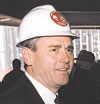...fewer than 200 members placing rebar in 18 states. That now is nearly 1,000. “Contractors who used to bid in those areas, who ceased bidding because they were not competitive, are back now and bidding,” Hunt says.
Painters’ union President Jim Williams didn’t face an election this summer, but spent time on the road anyway touting a business plan beginning to pay off. After a slight retreat from 130,000 members in 2003, numbers have bounced back. He credits practices borrowed from corporate America, such as an initiative to clearly define jobsite responsibilities of both employers and union members. The union also is getting its financial house in order. “We’ve done a complete across-the-board belt tightening from top to bottom,” Williams says. That has increased the painters’ general fund reserve six times over to $18 million since 2002. He also plans to sell its 80,000-sq-ft building in Washington, a step that could net the union another $20 million.
 |
| Loyal. Open shop work will remain, say some firms. (Photo by Michael Goodman for ENR) |
Such proceeds will help fund painters’ organizing efforts, with the hurricane-hit Gulf Coast a key target. The union has spent nearly $5.3 million there, but gained close to 700 members. Reconstruction needs will continue to become a recruiting tool for unions, although the open shop is a formidable challenger for construction talent.
The Business Roundtable upped the ante with its new $5-million plan to train up to 20,000 new construction workers in the region by 2009. Training will be conducted “primarily” by instructors certified by the open shop National Center for Construction Education and Research, Gainesville, Fla., says the Roundtable. Classes are filled up in Baton Rouge through September, says Tim Horst, the effort’s program manager. “But if we don’t have class space, I have no problem with people moving over and joining the union program,” he says. Notes union training official Callanan: “We are playing a significant role in building up a Gulf Coast work force.”
 |
| O’Sullivan |
How unions fare there could indicate how well they will do in other nonunion markets. Perceptions of hard-core union tactics are strong. The recent criminal conviction of laborers’ union officials in Niagara Falls, N.Y., doesn’t help (ENR 8/14 p. 15). O’Sullivan claims the offending officials were long gone from the local, which the international union took over and ran until 2004.
“Some organized labor tactics are not reasonable, fair or create a trusting atmosphere,” says Pete Vigue, president of Cianbro Corp., Pittsfield, Maine, a big nonunion contractor. “It boils down to what value they add.”
O’Sullivan is embarking on a national organizing blitz that will focus on 35 states where the laborers and other “basic trades” are weakest (see map p. 23). The union hopes for convention passage this month of a “historic” dues increase that would garner $103 million for the effort.
| + Enlarge this image |
 |
| Marketing. South and West are big targets. |
NCA is gearing up to snag a share of power projects, particularly in the South. “There’s potential for more than $10 billion of power work for the basic trades,” says Poupore, who declines to identify projects.
Residential construction is another target. Unions have identified the 10 fastest-growing markets (see map, right) and are undaunted even by signs of softening. With developer consolidation expected, “we want to show that we bring value” to the large ones who will be left, says Randy Mayhew, laborers’ union organizing director. Key to that market strategy is finding a plentiful labor pool.
 |
| Buildup. Unions eye residential construction for growth, but a softening market could threaten. (Photo by AP/Wideworld) |
Last month, the AFL-CIO signed a “partnership” pact with a group representing day laborers in the U.S.—legal and undocumented. The laborers’ union also is talking to the group, which so far has not committed to being organized, says Pablo Alvarado, national coordinator of the National Day Laborer Organizing Network, Los Angeles. “But our centers are under siege and we need to build whatever alliances we can,” he says.
Predictions of dire labor shortages are upending industry dynamics. “For 30 years, there was a raging debate whether union or merit shops were the best options. Now, it’s a moot point,” says Ken Hedman, a labor relations consultant in Arizona. “People only care who can supply the labor at this point.”


